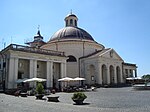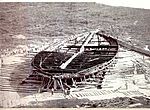Battle of Velletri
1744 in Europe1744 in ItalyBattles in LazioBattles involving SpainBattles involving the Kingdom of Naples ... and 4 more
Battles of the War of the Austrian SuccessionConflicts in 1744Italian history stubsSpanish battle stubs

The Battle of Velletri occurred on 12 August 1744 in the War of the Austrian Succession, between Austria and the Kingdom of Naples. After seizing Velletri in a nighttime attack and capturing much of King Charles' royal entourage, the Austrian army joined battle with Charles' army outside the city. The Austrians were rapidly thrown back and retreated north toward Rome with Charles in pursuit.
Excerpt from the Wikipedia article Battle of Velletri (License: CC BY-SA 3.0, Authors, Images).Battle of Velletri
Via Napoli,
Geographical coordinates (GPS) Address Nearby Places Show on map
Geographical coordinates (GPS)
| Latitude | Longitude |
|---|---|
| N 41.7 ° | E 12.683333055556 ° |
Address
IIS Sandro Pertini
Via Napoli 3
00045
Lazio, Italy
Open on Google Maps










